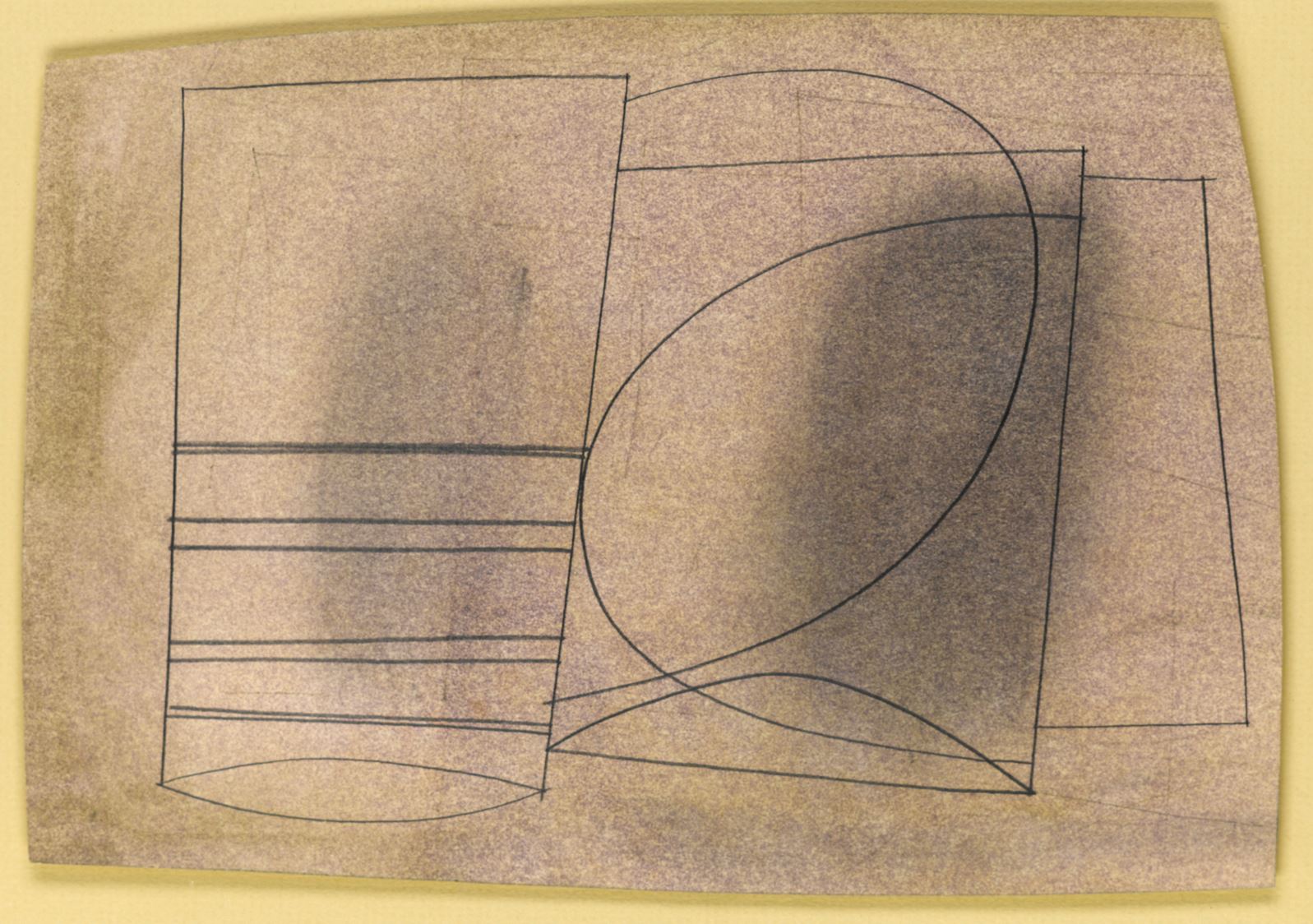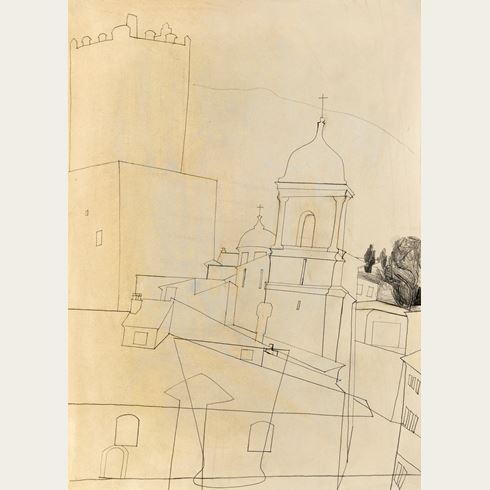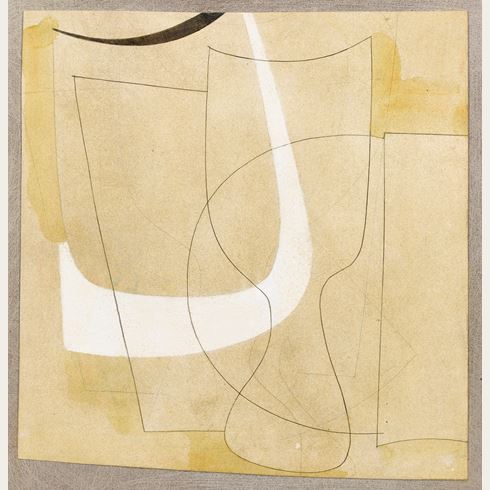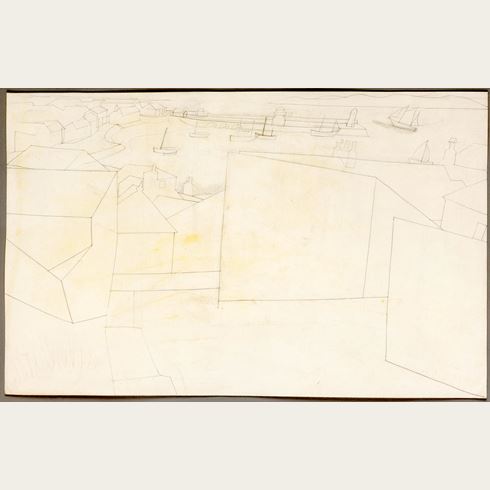Ben NICHOLSON
(Derham 1894 - London 1982)
December 1957 (for Jeanne Coppel)
Sold
Pencil on card, irregularly trimmed.
Signed, dated and dedicated for Jeanne Coppel / Ben Nicholson Dec 57 on the verso.
175 x 254 mm. (6 7/8 x 10 in.) at greatest dimensions.
Signed, dated and dedicated for Jeanne Coppel / Ben Nicholson Dec 57 on the verso.
175 x 254 mm. (6 7/8 x 10 in.) at greatest dimensions.
Ben Nicholson’s lifelong interest in still life can be traced to his youth. As he recalled of his father, the painter William Nicholson; ‘But of course I owe a lot to my father – especially to his poetic idea and to his still-life theme. That didn’t come from Cubism, as some people think, but from my father – not only from what he did as a painter but from the very beautiful striped and spotted jugs and mugs and goblets, and octagonal and hexagonal glass objects which he collected. Having those things throughout the house was an unforgettable early experience for me.’ Many of the same elements – jugs, goblets, carafes and so forth – appear in Nicholson’s still life compositions throughout his career. These objects, drawn in outline and depicted without volume as a series of overlapping lines, were intended to introduce a sense of rhythm and movement across the painted or drawn surface.
In the simplicity and clarity of its composition, the present sheet can be compared to a number of later drawings, such as April 1958 (Prato) and 1965 (linear still life), both today in private collections. Writing around the same time the present sheet was drawn, Sir Herbert Read noted that ‘Nicholson tries to achieve universality by organizing his aesthetic elements (outline, space, colour) into coherent systems of form. The outline of a jug or a table, a pattern of walls or roofs, may be formal shapes simple enough to fall into place – to constitute the faultless façade. But equally well the necessary forms may be altogether remote from the phenomenal appearance of objects – that is to say, they may be geometrical.’
This drawing was given by Nicholson to the artist Jeanne Coppel (1896-1971), possibly in exchange for one of her works. Born in Romania, Jeanne Coppel (née Helder) lived for some time in Berlin, where she met the artists of the Der Sturm group, before arriving in Paris in 1912 to study at the Académie Julian. She spent the years of the First World War in her native Romania but settled for good in Paris in 1919. As an artist, Coppel worked mainly in collage, in an abstract manner. She exhibited at the Salon des Réalites Nouvelles from 1948 onwards, and had her first solo exhibition in Paris in 1950. Further exhibitions of her work took place in Paris throughout the 1950’s and 1960’s.
In the simplicity and clarity of its composition, the present sheet can be compared to a number of later drawings, such as April 1958 (Prato) and 1965 (linear still life), both today in private collections. Writing around the same time the present sheet was drawn, Sir Herbert Read noted that ‘Nicholson tries to achieve universality by organizing his aesthetic elements (outline, space, colour) into coherent systems of form. The outline of a jug or a table, a pattern of walls or roofs, may be formal shapes simple enough to fall into place – to constitute the faultless façade. But equally well the necessary forms may be altogether remote from the phenomenal appearance of objects – that is to say, they may be geometrical.’
This drawing was given by Nicholson to the artist Jeanne Coppel (1896-1971), possibly in exchange for one of her works. Born in Romania, Jeanne Coppel (née Helder) lived for some time in Berlin, where she met the artists of the Der Sturm group, before arriving in Paris in 1912 to study at the Académie Julian. She spent the years of the First World War in her native Romania but settled for good in Paris in 1919. As an artist, Coppel worked mainly in collage, in an abstract manner. She exhibited at the Salon des Réalites Nouvelles from 1948 onwards, and had her first solo exhibition in Paris in 1950. Further exhibitions of her work took place in Paris throughout the 1950’s and 1960’s.
The son of the painters William Nicholson and Mabel Pryde, Ben Nicholson spent a brief period at the Slade School of Art in London but was otherwise without formal artistic training. It was not until 1920 and his marriage to the painter Winifred Dacre that he began to paint seriously, producing mainly still life and landscape paintings throughout the following decade. In 1932 he and his second wife, Barbara Hepworth, traveled to France and there met and befriended Pablo Picasso, Georges Braque, Constantin Brancusi and Jean Arp, and later Piet Mondrian. It was also at this time, in the 1930’s, that Nicholson began to work in a more Cubist manner, creating paintings and reliefs made up of abstract geometrical forms, and in particular producing a series of carved and painted white reliefs that have become icons of 20th century English modernism. At the outbreak of the Second World War, Nicholson and Hepworth and their children moved to the town of St. Ives in Cornwall, where they became the nucleus of a vibrant artistic community. Nicholson’s reputation grew significantly after the war, and he won several artistic prizes in America and elsewhere. In 1954 a retrospective exhibition of his work was held in the British pavilion at the Venice Biennale, followed a year later by one at the Tate. In 1958 he left St. Ives and settled in Switzerland, having annulled his marriage to Hepworth in 1951 and remarried. A second Tate retrospective in 1968 was accompanied by the awarding of the Order of Merit.
Drawing was an important part of Nicholson’s artistic process throughout his career. His drawings were, however, not made as studies for carved reliefs or paintings, and it should be noted that ‘more than simply preparatory or exploratory tools, drawings were to him full-blown works of art…His drawings are characterized by a strong continuous line, which sinuously defines form and space without a break. Shading is used sparingly and any illusion of volumetric mass simply suggested by the interweaving lines.’
Provenance
Given by the artist to Jeanne Coppel, Paris
By descent to her son, until 2007
Anonymous sale, Paris, Christie’s, 11 December 2007, lot 192
Stephen Ongpin Fine Art, London, in 2008
Private collection, Madrid.







